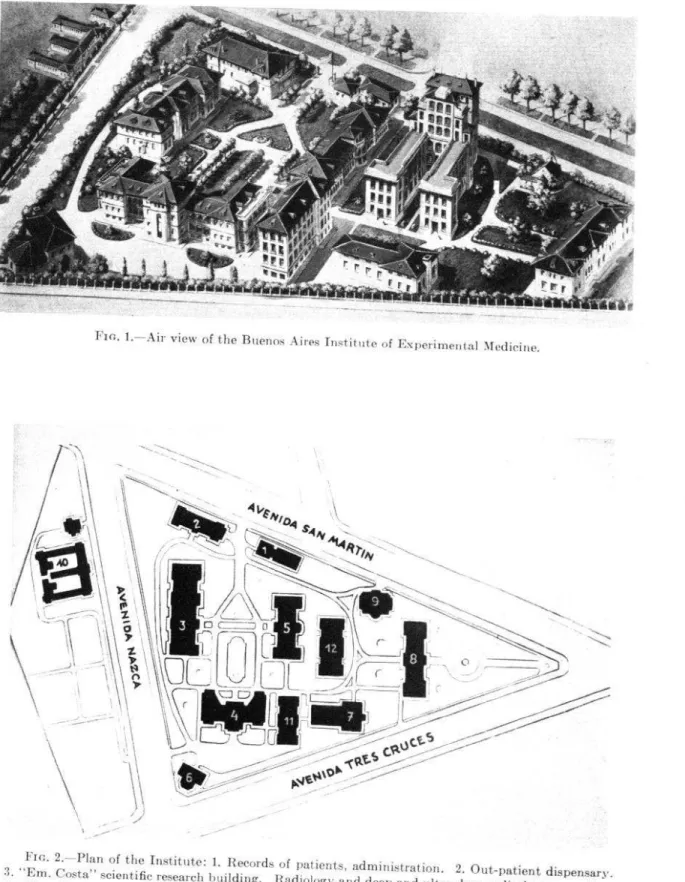SCIENTIFIC INSTITUTIONS IN LATIN AMERICA -___
INSTITUTE
OF EXPERIMENTAL
MEDICINE
FOR THE
STUDY AND TREATMENT
OF CANCER
Director: Dr. A. H. ROFFO Buenos Aires, Argentina
[EDITORIAL NOTE.-This is one of a series of articles describing the principal scientific institutions in Latin America. These articles have been prepared with the cooperation of the heads of the organieations concerned.]
The Institute of Experimental Medicine for the Study and Treatment of Cancer was inaugurated November 7, 1923, and is part of the Uni- versity of Buenos Aires.
Under the leadership of its Director, Professor A. H. Roffo, the Institute has been developed to cover every phase of cancer research- including social welfare as well as scientific experimentation. The activities of the biologist, the chemist, the physicist, the microbiologist, the pathologist, and the physician are thus al1 brought to bear on the problem.
The Institute, which began with a single building, now has twelve, and occupies about twelve and a half acres. Its annual budget includes a fixed appropriation of 260,OOO.OO pesos argentinos (about $78,550), with additional grants and donations.
The organization of the Institute is on a three-fold basis: (1) medical research, (2) medical care (diagnosis and treatment), and (3) social work.
The Division of Medical (or Scientific) Research includes: ex- perimental cancer; bio-chemistry; physical chemistry; experimental pathology; tissue culture; radio-biology; pathologic anatomy; experi- mental surgery. While research is directed chiefly to the study of ’ malignant tumors, other diseases of obscure etiology are not neglected. Promising new findings on etiology and treatment of cancer are in- vestigated by the Institute, and its laboratories are open to workers in this field, so long as they abide by the rules of the Institute. Ac- counts of al1 work carried on in the Institute are published in its Bul- letin, the Boletin del Instituto de Medicina Experimental para el estudz’o g tratamiento del cáncer.
The Division of Medical Care or Relief includes a dispensary for the early diagnosis and outpatient treatment of cancer; and hospitaliza- tion facilities. To date, 82,000 persons have been registered in the dispensary. The clinics, at the disposal of the public as well as physi-
947
948
OFICINA SANITARIA PANAMERICANA [Octubrecians, are open every day. After a first examination in the general clinic, the patient is seen by a specialist on the site of the disease- throat, skin, digestive system, etc. Following a very complete examina- tion, the patient is asked to return in 48 hours for definite diagnosis and treatment. The latter may consist in electro-surgery, deep radio- therapy, ultra-deep radio-therapy, radium, and other measures. The annual number of patients has risen from 1,772 in 1923 to 8,554 in
l 1938; the number of consultations from 6,767 to 91,752, and the number
of treatments from 3,900 to 50,279, a total of 354,000 treatments to date.
There are three pavilions devoted to the hospitalization of patients, with a total of 600 beds. In 1923, 422 persons were hospitalized, and in 1938,3,174, a total of 27,599.
Social welfare work is carried on by the Institute, not only by fur- nishing care to every patient coming to the Institute, whatever his social condition, but also by public education through leaflets and lectures. A cancer hour is held every Saturday, which cultural groups, schools, etc., may attend. A visiting nurse service has been established; the nurse visits the home of the patient, and is able in many instances to see that the patients, especially women patients, are not taken from their home duties. Thus a mother may continue her usual life, main- taining contact with the Institute through the visiting nurse, who will keep track of her condition, and te11 her when to come to the clinic.
The Institute operates a School of Nursing, and also gives courses in Cancerology. Physicians are allowed to attend the clinics held in the dispensary.
1939 1 SCIENTIFIC INSTITUTIONS
949
FIG. l.-Air view of the Birenos Aires Institute of Experimental Medicine.
fìro. 2.-Plan of the Institute: 1. Records of patients, administration. 2. Out-patient dispensary, 3. “Em. Costa” scientific research huilding.
4. “Elena Laroque de Roffo” lOO-bed building.
Radioloay and deep and ultra-deep radiotherapy section. 5. Hospital 100 beds.
7. ñitrhen. 8. Nurses’ home. 9. Chape]. 10. Animal ho’me.
6. Morgue, laundry, rat breedina.
12. Model hospital, 250 beds.
950
OFICINA SANITARIA PANAMERICANA4 [Octubre 1939 ]E’Ic. 3.-T’iew of the “Elena Laroque de Iioffo” hospital
exidence at the inauguration of the Institrite in 1923. for men. This wa.3 the only huilding in
1’IG. 4.- ‘1
